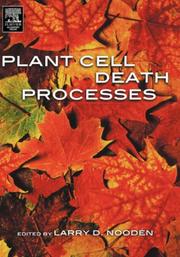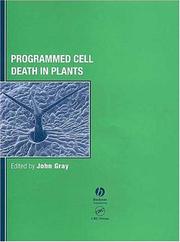| Listing 1 - 8 of 8 |
Sort by
|

ISBN: 9780125209151 0125209150 9780080492087 0080492088 1281005541 9781281005540 9786611005542 Year: 2004 Publisher: Amsterdam : Boston : Elsevier Academic Press,
Abstract | Keywords | Export | Availability | Bookmark
 Loading...
Loading...Choose an application
- Reference Manager
- EndNote
- RefWorks (Direct export to RefWorks)
Programmed cell death is a common pattern of growth and development in both animals and plants. However, programmed cell death and related processes are not as generally recognized as central to plant growth. This is changing fast and is becoming more of a focus of intensive research. This edited work will bring under one cover recent reviews of programmed cell death, apoptosis and senescence.Summaries of the myriad aspects of cell death in plants Discussion of the broadest implications of these disparate results A unification of fields where there has been no cross talk

ISBN: 1280459794 9781402022174 9786610459797 1402022174 1402022166 Year: 2004 Volume: 4 Publisher: Dordrecht : Kluwer Academic Publishers,
Abstract | Keywords | Export | Availability | Bookmark
 Loading...
Loading...Choose an application
- Reference Manager
- EndNote
- RefWorks (Direct export to RefWorks)
The series 'Cell Engineering' is the first and only major reference work on the development of cellular systems for the production of recombinant glycoproteins, gene and cell therapies, drug screening and tissue engineering. This volume on 'Apoptosis' is intended to review the state-of-the-art with in-depth assessments of this type of programmed cell death. The aim of the volume is to make the recent developments in apoptotic research readily accessible to biologists, biotechnologists and cellular engineers. The implication of apoptosis in the suppression of diseases and prolonging survival of
Apoptosis. --- Cell death. --- Cell degeneration --- Cells --- Death (Biology) --- Cell death

ISBN: 0801441188 Year: 2004 Publisher: Ithaca (N.Y.) : Comstock,
Abstract | Keywords | Export | Availability | Bookmark
 Loading...
Loading...Choose an application
- Reference Manager
- EndNote
- RefWorks (Direct export to RefWorks)
Aging. --- Cell death. --- Death (Biology).
Book
Year: 2004 Publisher: Bruxelles: UCL. Faculté de pharmacie et des sciences biomédicales,
Abstract | Keywords | Export | Availability | Bookmark
 Loading...
Loading...Choose an application
- Reference Manager
- EndNote
- RefWorks (Direct export to RefWorks)
Le cancer est le résultat de la croissance autonome d'un tissu qui mène à une dédifférenciation cellulaire progressive. La cellule prolifère de manière anormale en échappant à tout système de contrôle. Outre cette perte de contrôle du cycle cellulaire, la cellule tumorale se caractérise par une autonomie énergétique, par une capacité invasive et par une augmentation de la capacité de survie. Cette dernière caractéristique résulte d'une dérégulation du déclenchement de l'apoptose par mutation au niveau de la protéine p53 ou par surexpression des protéines de la famille de bcl-2 .La réactivation du processus apoptotique constitue donc une voie thérapeutique intéressante, déjà exploitée par les agents chimio- et radiothérapeutiques.La stratégie développée au laboratoire est basée sur l'induction d'un stress oxydatif au sein des cellules tumorales par l'administration combinée des vitamines C et KJ. Celles-ci, déficientes en enzymes antioxydantes, y sont plus sensibles que les cellules saines. L'activité cytotoxique de l'association vitaminique résulterait en effet de l'installation d'un cycle redox qui dérègle l'homéostasie redox suite à la production d'espèces réactives de l'oxygène.Le type de mort cellulaire observé pour la majorité des cellules traitées par les vitamines C et K3 fut nommée « autoschizis ». L'autoschizis montre des caractéristiques morphologiques intermédiaires entre l'apoptose et la nécrose. De plus, l'absence d'activation de la caspase-3 et la fragmentation aléatoire de l'ADN rejette l'hypothèse de l'apoptose.Les mécanismes moléculaires de cette mort cellulaire ne sont pas encore bien connus. L'orthovanadate de sodium, un inhibiteur des tyrosines phosphatases, s'est toutefois montré capable de diminuer l'effet toxique des vitamines C et K3. Ceci suggère que certaines protéines, en fonction de leur état de phosphorylation, jouent un rôle majeur dans cette cytotoxicité .Sur base de ce résultat , deux processus cellulaires ont été ciblés. L'un concerne une voie de transduction du signal, la cascade des MAP Kinases, l'autre porte sur une voie métabolique essent ielle aux cellules cancéreuses, la glycolyse.D'après les résultats, la voie des MAP Kinases ne serait pas activée lors de l'administration des vitamines. Les MAP Kinases ne semblent pas être impliquées dans ce mécanisme de mort cellulaire . La glycolyse, par contre, est fortement inhibée par l'association des vitamines. Les enzymes cibles ainsi que le mécanisme de cette inhibition ne sont cependant pas encore connus et sont maintenant à l'étude au laboratoire.
Cell Death --- Ascorbate Peroxidases --- Vitamin K 3 --- Tumor Cells, Cultured

ISBN: 1841274208 0849319803 9781841274201 Year: 2004 Publisher: Oxford : Blackwell,
Abstract | Keywords | Export | Availability | Bookmark
 Loading...
Loading...Choose an application
- Reference Manager
- EndNote
- RefWorks (Direct export to RefWorks)
For the first time in a single volume, researchers from seven countries review new knowledge and studies on programmed cell death (PCD) as it applies to plants, and draw comparisons with systems in animals and unicellular organisms. Chapters cover the major pathways of PCD in plants and animals, describe the cell death events in reproductive and vegetative tissues, outline examples of PCD in response to abiotic and biotic stress, and present future applications and methods. Programmed Cell Death in Plants serves as the source of ideas for the development of new research strategies and model systems regarding the phenomenon of PCD in plants.
Plant cells and tissues --- Plant physiology --- Cell death --- Plant cell biotechnology --- Cell death. --- Plant cell biotechnology. --- Plant cells and tissues. --- Plant physiology.

ISBN: 1281005541 9786611005542 0080492088 0125209150 9780125209151 9780080492087 9781281005540 Year: 2004 Publisher: Amsterdam Boston :Elsevier Academic Press
Abstract | Keywords | Export | Availability | Bookmark
 Loading...
Loading...Choose an application
- Reference Manager
- EndNote
- RefWorks (Direct export to RefWorks)
Programmed cell death is a common pattern of growth and development in both animals and plants. However, programmed cell death and related processes are not as generally recognized as central to plant growth. This is changing fast and is becoming more of a focus of intensive research. This edited work will bring under one cover recent reviews of programmed cell death, apoptosis and senescence.Summaries of the myriad aspects of cell death in plants Discussion of the broadest implications of these disparate results A unification of fields where there has been no cross talk
Plant physiology. --- Cell death. --- Cell degeneration --- Botany --- Plants --- Physiology --- Cells --- Death (Biology)

ISBN: 0896038734 9786610359936 1280359935 1592598129 9780896038738 Year: 2004 Volume: 282 Publisher: Totowa, NJ : Humana Press : Imprint: Humana,
Abstract | Keywords | Export | Availability | Bookmark
 Loading...
Loading...Choose an application
- Reference Manager
- EndNote
- RefWorks (Direct export to RefWorks)
The ability to detect and quantify apoptosis, to understand its biochemistry, and to identify its regulatory genes and proteins is crucial to biomedical research in the 21st century. In Apoptosis Methods and Protocols, highly experienced researchers in the field of apoptosis describe in step-by-step detail the techniques they have perfected to investigate the critical steps involved in the apoptotic process. These readily reproducible methods range from flow cytometry and immunohistochemical procedures to kinase activity assays, yeast two-hybrid screening, and the cloning of novel genes by differential expression. The protocols follow the successful Methods in Molecular Biology™ series format, each one offering step-by-step laboratory instructions, an introduction outlining the principle behind the technique, lists of equipment and reagents, and tips on troubleshooting and avoiding known pitfalls. State-of-the-art and highly practical, Apoptosis Methods and Protocols constitutes a key technical reference to the significant methodologies used in the field, as well as offering novice and experienced researchers alike powerful tools to illuminate the phenomenon of programmed cell death.
Apoptosis --- Molecular biology --- DNA Damage --- physiology --- Apoptosis -- Laboratory manuals. --- Molecular biology -- Laboratory manuals. --- Biological Science Disciplines --- Genetic Processes --- Cell Death --- Publication Formats --- Publication Characteristics --- Genetic Phenomena --- Cell Physiological Processes --- Natural Science Disciplines --- Disciplines and Occupations --- Phenomena and Processes --- Cell Physiological Phenomena --- Laboratory Manuals --- Physiology --- Biology --- Health & Biological Sciences --- Cytology --- Cell death --- Cytology. --- Cell Biology. --- Cell biology --- Cellular biology --- Cells --- Cytologists --- Apoptosis - Laboratory manuals. --- Molecular biology - Laboratory manuals. --- DNA Damage - physiology - Laboratory Manuals. --- Apoptosis - physiology - laboratory manuals

ISBN: 0879696729 Year: 2004 Publisher: Cold Spring Harbor Cold Spring Harbor laboratory press
Abstract | Keywords | Export | Availability | Bookmark
 Loading...
Loading...Choose an application
- Reference Manager
- EndNote
- RefWorks (Direct export to RefWorks)
Cells --- Cellular control mechanisms --- Cell cycle --- Cell death --- Cellules --- Régulation cellulaire --- Cycle cellulaire --- Growth --- Croissance --- Mort --- Cell cycle. --- Cell death. --- Cellular control mechanisms. --- Growth. --- 57.017.64 --- 576.32/.36 --- Growth. Development. --- Cell physiology. Cell biochemistry. Cell biophysics. Molecular biology of the cell --- 576.32/.36 Cell physiology. Cell biochemistry. Cell biophysics. Molecular biology of the cell --- 57.017.64 Growth. Development. --- Régulation cellulaire --- Cell regulation --- Biological control systems --- Cell metabolism --- Cell growth --- Cell proliferation --- Cell degeneration --- Death (Biology) --- Mitotic cycle --- Nuclear cycle (Cytology) --- Biological rhythms --- Growth. Development
| Listing 1 - 8 of 8 |
Sort by
|

 Search
Search Feedback
Feedback About
About Help
Help News
News